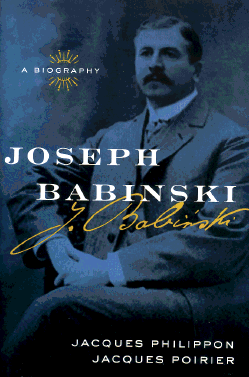
dimanche 1 mars 2008 la lettre d'information du site baillement.com N°77 Si vous ne voyez pas les images, cliquez ici pour lire cette lettre dans votre navigateur. If you cannot see pictures below, to view the email in your web browser click here baillement.com est libre d'accès, base documentaire pour comprendre, chercher, travailler
-
Yawning and subjective sleepiness - in the ederly
- Zilli I, Giganti F, Uga V
- J Sleep Res
- 2008;17:303-308
- Sleep Lab. Dept. of Psychology
- University of Florence
- Firenze - Italy
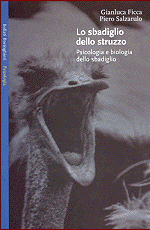
- Gianluca Ficca & Piero Salzarulo
- "Lo Sbadiglio Dello Struzzo"
- Bollati Boringhieri
- Torino, 2002
- Yawning and behavioral states in premature infants
- Giganti F, Hayes MJ, Akilesh MR, Salzarulo P.
- Developmental Psychobiology
- 2002;41(3):289-96
- Yawning frequency and distribution in preterm and near term infants assessed throughout 24-h recordings
- Giganti F, Hayes MJ Cioni G, Salzarulo P.
- Infant Behav & Development
- 2007;30(4):641-647
- The functional relationship between yawning and vigilance
- Guggisberg AG, Mathis J, Herrmann US, Hess CW
- Behav Brain Res
- 2007;179(1):159-166
- Yawning in morning and evening types
- Zilli I, Giganti F, Salzarulo P.
- Physiol Behav
- 2007;91(2-3):218-222
-
Yawning across the life span - Yawning is related to sleep/wake transitions and time of day, probably reflecting the time course of sleepiness. As aging modifies sleep-wake and sleepiness rhythms, does yawning frequency and its time course vary as a function of age?
- Yawning frequency is reduced in aged subjects compared with their younger counterparts, supporting the previous report by Walusinski (2006).....
- It is noteworthy that the reduction of yawning frequency in aged subjects is not spread throughout wakefulness: aged subjects yawn less frequently than young adults during the morning and in the mid-afternoon. This result could be explained by the age-related shift towards morningness, previously highlighted (for review, Monk and Kupfer, 2007) and replicated in the present study. In fact, a recent research (Zilli et al., 2007) emphasized that morning-types yawn less frequently than evening-types particularly during daytime....
- Although both elderly and young subjects yawn more frequently early in the morning and late in the evening, aged subjects show earlier morning peak and evening rise compared with the young adults, according to the earlier sleep times. In addition, aged subjects exhibit two minor yawning peaks, which occur early in the afternoon and early in the evening. The time course of sleepiness across wakefulness is related to the time course of yawning in both age groups. This finding is consistent with the association between yawning and sleepiness emphasized by previous researches (Guggisberg et al., 2007; Provine et al., 1987; Zilli et al., 2007) and it underscores that this link is evident even in the elderly.
- Changes as a function of age in the time course of yawning are associated with changes in the time course of sleepiness. The lower sleepiness levels reported by the aged subjects during morning hours could account for the reduction of yawning frequency observed in this part of the day. It is also noticeable that the two additional yawning peaks, detected in the midst of wakefulness period in the elderly, approximately correspond to sleepiness rises. Furthermore, the advanced evening rise in yawning frequency showed by aged subjects matched up with the advanced sleepiness increase.
- It is remarkable that the rise of yawning before sleep parallels the increase of sleepiness in both age groups, whereas yawning peak after the awakening is not associated with high sleepiness level in the aged subjects. This discrepancy suggests that the time course of subjective sleepiness by itself could not give an explanation for all of the yawning frequency oscillations: the relationship between yawning frequency and the proximity of wake&endash;sleep and sleep&endash;wake transitions should also be taken into account. It seems reasonable to suppose that sleepiness level and sleep episode proximity could separately affect yawning, even though further researches including sleep-wake rhythm manipulation and sleepiness objective measurement are necessary to clarify their respective role.
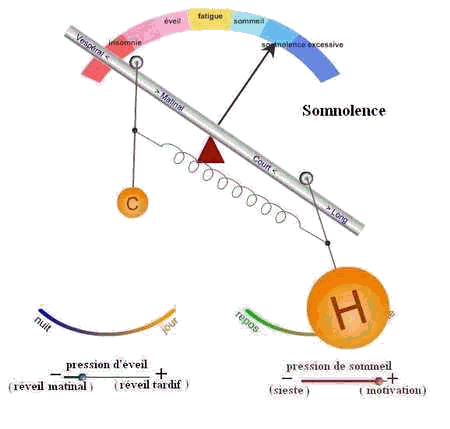
le site du Docteur Guilhem Pérémarty son balancier veille - sommeil - Le bâillement tout au long de la vie
- Le bâillement est corrélé au rythme veille/sommeil et aux périodes de transition entre ces deux comportements, reflétant l'état de somnolence. La fréquence des bâillements est diminuée chez les sujets âgés comparativement à celle des jeunes adultes, comme l'a rapporté le travail antérieur de Walusinski (2006).
- Il est à noter que la réduction de cette fréquence liée au vieillissement n'est pas répartie de façon homogène au cours du nycthémère. C'est essentiellement le matin et en milieu d'après midi que cette réduction a lieu. Ceci peut s'expliquer par la tendance à l'avance de phase avec des éveils plus tôt chez les sujets âgés, chose déjà notée dans des publications antérieures et retrouvée ici. En fait, un travail récent avait montré que les sujets du matin bâillent moins que ceux du soir (Zilli et al., 2007).
- Les sujets âgés montrent deux pics d'augmentation de fréquence de leurs bâillements, tôt dans l'après-midi (somnolence post-prandiale, sieste fréquente par fragmentation du temps de sommeil total), et plus précocément en soirée que chez les jeunes (avance de phase). Ceci montre bien la corrélation étroite entre somnolence et bâillements et souligne ce lien très fort chez les personnes âgées (Guggisberg et al., 2007; Provine et al., 1987; Zilli et al., 2007). Ces changements d'horaires des bâillements apparaissent donc associés aux changement des horaires de somnolence au cours du nycthémère.
- Il est intéressant de noter que l'augmentation de fréquence des bâillements avant l'endormissement se retrouve dans les deux groupes étudiés alors que les bâillements suivant l'éveil ne sont pas rapportés à de la somnolence chez les sujets âgés. Cette différence suggère que ce n'est pas la sensation subjective de somnolence en elle-même qui explique les différences de fréquence des bâillements. Il paraît raisonnable de supposer que la somnolence et la proximité de l'endormissement affectent indépendamment l'apparition des bâillements. De futurs recheches seront nécessaires pour préciser tous ces points.
-
Biopercular syndrome: - report of two cases and literature review
- Millan PA, Montes MI, Uribe CS et al
- Biomédica
- 2008;28(2):183-190
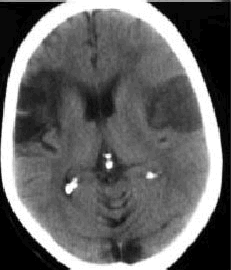
- Yawning and stroke
- Bâillements et AVC
-
Automatic-voluntary dissociation of orofaciolingual-pharyngeal motility - The anterior opercular or biopercular syndrome (Foix-Chavany syndrome) is a cortical pseudobulbar palsy due to bilateral lesions of the anterior brain operculum. It is characterized by preservation of reflex function and automatic activity, without mental impairment. Two cases are reported herein and the relevant literature reviewed. (spanish language)
- The first case was a 73-year-old female with a history of a stroke occurring seven years previously, without sequelae in the interim. She presented with sudden loss of consciousness. The neurological examination showed a right facial central palsy and anarthria, with reflex acts such as smiling, blinking and yawning, not elicited by commands; she also had a right hemiparesis and walking impairment. A brain CT scan showed an old ischemic infarction in the region of the right medial cerebral artery. Because the right motor involvement did not correlate with the findings of the initial CT scan, another CT scan two days later showed an acute brain infarction in the vicinity of the left medial cerebral artery.
- The second case was an 8-year-old girl with mental retardation and impairment of verbal development, caused by of biopercular pachygyria.
- Facio-pharyngo-glosso-masticatory diplegia and volitional selective palsy of the oro-facial muscles was seen in both patients. The neuropsychological assessment showed cognitive, emotional and social interaction impairment in both cases as part of the frontal convexity syndrome in the first case and of mental retardation in the second. The two patients had difficulty in mastication and swallowing but were able to smile and yawn. The prognosis for recovery of verbal capacity is poor, although generally most patients recover the ability to swallow.
- Dissociation automatico-volontaire
- Le syndrome operculaire ou syndrome de Foix Chavanny est caractérisé par une paralysie faciale centrale (atteinte opercule rolandique bilatérale), une paralysie linguale et linguo-pharyngée affectant toute la motricité volontaire tandis que la motilité automatique, émotionnelle en particulier est préservée. Ainsi la malade sourit et bâille.
- The opercular syndrome - diagnostic trap in facial paralysis Crumley RL The laryngoscope 1979;89:361-365
- Syndrome de Foix Chavany Marie d'origine traumatique Laurent-Vannier A Rev Neurol 1999;155(5):387-390
- Bilateral anterior operculum syndrome Billeth R, Jorgler E, Baumhackl U Nervenarzt 2000;71(8):651-654
- Dissociated preservation of automatic-voluntary jaw movements in a patient with biopercular and unilateral pontine infarcts Ghika J, F Vingerhoets, J Bogousslavsky Eur Neurol 2003;50:185-188
- La diplegie faciale cérébraIe (forme corticale de la paralysie pseudo-bulbaire) Alajouanine T, Thurel R Rev. Neurol 1932;38:516-517
- Le Syndrome operculaire unilatéral avec atteinte controlatérale du territoire des V, VII, IX, XI, XIIe nerfs craniens Alajouanine T et al Rev. Neurol 1959;101:168-171
- Le syndrome operculaire unilatéral d'origine vasculaire Pertuiset B, F Perrier Rev Neurol 1960;103:63-64
- Le syndrome operculaire unilatéral d'origine vasculaire Boudin G, B Pépin, JP Wiart Rev Neurol 1960;103;65
-
Joseph Babinski: a biography - The life and work of Joseph Babinski (1857-1932) has been revisited by two French physicians whose enthusiasm for the subject is reflected in the depth and breadth of documentary sources. From Babinski's Polish roots, his father (an intrepid revolutionist), his brother(the gold miner and famous gastronome Ali-Bab) to the Babinski circle, his friends, his colleagues and his disciples, the reader will find a refreshing perspective on a particularly fascinating period in French medicine.
- His scientific contribution is analyzed in detail, with for the first time a complete bibliography of his publications. These includes not only the Babinski Sign, but also the earlier and heretofore less-known concerning pathological anatomy and histology, the papers on cutaneous and tendinous reflexes, cerebellar and vestibular semeiology, hysteria and pithiatism, localization of spinal cord compression s and the birth of French neurosurgery.
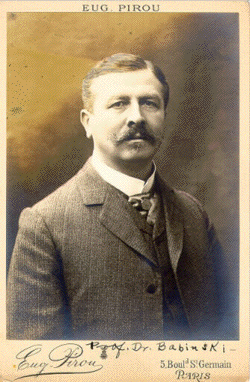
- Joseph Babinski: une biographie
- J. Philippon, neurochirurgien et J. Poirier, anatomopathologiste ont uni leurs talents d'historiens pour brosser la fresque de la vie de Joseph Babinski en embrassant une vaste source documentaire historique et bibliographique. Depuis ses origines polonaises (son père fut un ardent patriote révolutionnaire anti-russe), son frère (explorateur minier et réputé gastronome, auteur, sous le nom d'Ali-Bab, d'un fameux recueil culinaire) juqu'à ses amis, ses collègues et ses élèves, les auteurs passent en revue et pénètrent tous les détails d'une vie qui éclairent les heures les plus glorieuses de cette période si riche en découvertes de la médecine française de la fin du XIX° siècle.
- Les contributions de J. Babinski à la neurologie sont présentées et analysées en détails, mises en perspective avec les questions qui se posaient avec acuité, à l'époque, comme la distinction entre hémiplégie organique et hystérique; c'est ainsi qu'est abordé le fameux signe plantaire que tous les médecinns du monde nomme encore aujourd'hui signe de Babinski dans leur pratique quotidienne. Mais les auteurs dévoilent aussi les travaux antérieurs d'anatomie et d'histopathologie, ainsi que les contributions de J. Babinski à l'étude des réflexes tendineux, de la sémiologie cérébelleuse et vestibulaire, de l'hystérie rebaptisée pithiastisme sans négliger la sémiologie médullaire permettant la localisation purement clinique mais précise des compressions médullaires, ouvrant l'ère de la neurochirurgie française.
- Les auteurs insistent sur la minutie et la précision de l'examen clinique réalisé par J. Babinski, presque obsessionnel. Le 11 octobre 1904, il commence sa leçon de clinique par ces termes: "j'estime que les erreurs de diagnostic proviennent bien moins souvent d'une fausse interprétation que d'une observation imparfaite des symptômes, qu'elles sont ordinairament liées à des erreurs de sémiotique". Tout est dit, rien n'a changé, et les images n'y changeront rien.
- Lire aussi la biographie: "Sous le signe de Babinski" Hubert Déchy. Association des amis de la BIUM - 2007
-
Trophic nerves - R. Wyburn-Mason
- Henry Kimpton ed
- London
- 1950
- Le syndrome de Wyburn-Mason ou de Bonnet-Dechaume-Blanc comprend l'association de malformations artério-veineuses du maxillaire, de la rétine, du nerf optique, du thalamus, de l'hypothalamus et du cortex cérébral. La prévalence du syndrome n'est pas connue mais il est très rare : moins de 100 cas ont été publiés à ce jour.
- Wyburn-Mason syndrome is characterized by the association of arteriovenous malformations with a metameric topography located in the facial and ocular-orbital regions or involving the central nervous system. The syndrome is very rare with about 100 cases reported in the literature so far.
-
Bulbar Structures Concerned in Primitive Movements - Yawning still occurs after bilateral motor decortication in man or in decorticate lower mammals. In the former it is completely uncontrollable, as it may be in normal subjects. Yawning not only involves a wide opening of the mouth, but is preceded by a deep inspiration. The eyes often close and the act is often followed by pilo-erection and shivering. In biteral motor decorticate man yawning is accompanied by gross moves of the large joints (associated movements).
- Curious attacks of yawning and respiratory disturbance may follow an attack of encephalitis lethargica, which especially damages the hypothalamus and the region of the substantia nigra. Yawning would thus appear to depend on the structures in the bulb or hypothalamus and to be closely related respiratory activity.
- It occurs :
- (1) In states of tiredness and sleepiness, in which there is a depression of adrenergic and an increase of trophic cholinergic activity throughout the brain.
- (2) In conditions of excessive heat, when there is a general increase of cholinergic activity in the body and sleepiness.
- (3) During anxiety, when a similar general stimulation of trophic and autonomic functions occurs.
- (4) During the induction of amesthesia with barbituates, which depress adrenergic activity and induce sleep.
- (5) In animals in states of anaphylactic shock, when the initial stimulation of all trophic and autonomie is followed by a depression of adrenergic activity.
- (6) During boredom, when adrenergic activity is deficient.
- Yawning thus occurs when there is a general increase of trophic cholinergic activity within the nervous system and thus when respiratory activity is diminished and anoxia tends to develop. Since general stimulation of adrenergic activity in the body increases the depth of respiration, the deep inspiration which precedes a yawn, and the pilo-erection and shivering, which follow indicate an increased adrenergic activity. This seems to be an attempt to increase the oxygenation of the blood by stimulation of the respiratory centres. The excitation of the structures in the reticular formation initiated by the activity of the substantia nigra apparently spreads to neighbouring nuclei and induces opening of the jaws and the primitive slight movements of the large joints occurring in bilateral motor decorticate man.
-
Joseph Ducreux - Nancy 1735 - 1802 Paris
- Self-Portrait As A Yawning Man
- 1791
- Estampe 46 x 61 cm
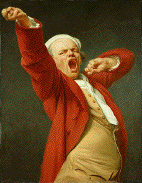
-
Joseph Ducreux, connaissant les limites du genre de l'autoportrait, préfère inventer, ici, une image inhabituelle, humoristique, le montrant bâillant et s'étirant, avec la satisfaction qui sied. Tenue décontractée, qui bâille aussi, couleurs vives, turban de nuit sur le chef, aspect négligé, tout concourt à faire partager l'intimité du peintre. Voilà un tableau original pour l'époque. - Joseph Ducreux experimented with the traditional limitations of the genre of self-portraiture by creating an expressive, humorous, and rather unorthodox image of himself stretching and yawning. Dressed informally in a turban and bright red jacket, Ducreux, in the midst of a huge yawn, opens his mouth wide, contorting his face with the effort and stretching his right arm toward the viewer. Holding this exaggerated pose, his back sways and his stomach pushes forward; his entire body presses up close to the surface of the picture.
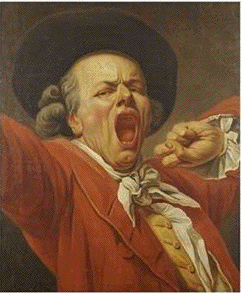
- French painter, pastellist and engraver, Ducreux lived in Paris from 1760 and from 1762 kept a list of his works. Among the portraits he completed in his early years were those in pastel of the well-known connoisseurs Pierre-Jean Mariette, the Comte de Caylus and Ange-Laurent de La Live de Jully, which apparently were copies after Maurice-Quentin de La Tour. Ducreux has traditionally been seen as de La Tour's favourite pupil, while Jean-Baptiste Greuze is supposed to have initiated him into oil painting. From his age, it can be assumed that by the time Ducreux reached Paris he had already acquired a grounding in his art. (see other works)
- Peintre français de pastels et d'estampes, Ducreux vécût à Paris de 1760 à 1762. Il paracheva sa technique des pastels auprès du célèbre Pierre-Jean Mariette, le comte de Caylus et Ange-Laurent de La Live de Jully, qui copiaient apparamment Maurice-Quentin de La Tour. Ducreux est traditionnellement considéré comme un des élèves favoris de de la Tour, alors qu'il semble que ce soit Jean-Baptiste Greuze qui l'initia à la peinture à l'huile. Compte-tenu de son âge il est probable que Ducreux possédait déjà un bon niveau quand il arriva à Paris (voir d'autres tableaux)
-
Rararum Observationum Medicinalium Decades tres continentes, historias medicas, theorica & practica varia - 1624
- Philippi Hechstetteri
- 17/11/1579 - 19/11/1635
- Augustae Vindelicorum ed
- Typis : Andreae Aspergeri
- p 192-198
- Les thèses en latin
-
Oscitatio periodica frequens, cum spasmodica thoracis concussione 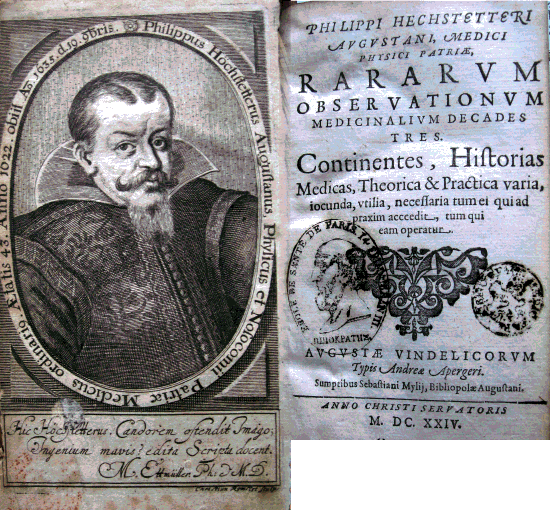
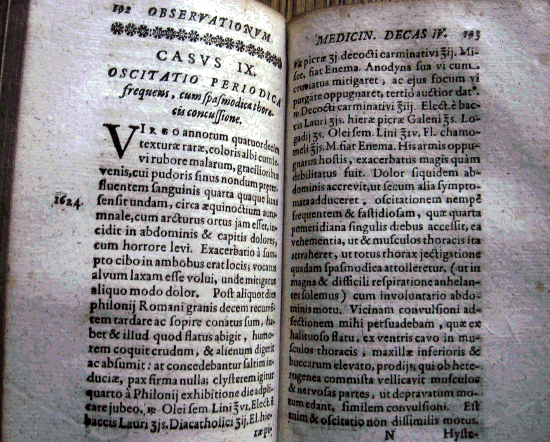
-
Autres documents mis en ligne ce mois-ci :
- Oscitatione Boerhaave H. 1762
- Des causes du soupir et du bâillement Matice CF 1846
- Le bâillement sur France-Culture "Avec ou sans rendez-vous" avec le Prof O. Lyon Caen
- Biographie d'André Trautmann
- F.X Messerschmidt - Der Gähner
- Amelioration of pathological yawning after tracheostomy in a patient with locked-in syndrome Prasad H
- Yawning Surprising facts ans misleading myths about our health Anahad O'Connor
- Contagious and spontaneous yawning in autistic and typically developing children Giganti F, Ziello ME
- Venlafaxine-induced excessive yawning. Chen CH, Lu ML.
Résultats du sondageau 28 février 2009 Recherche par mot du site
-
Nombre de questionnaires remplis : 3584 - Combien de fois bâillez-vous par jour ? <5 = 24,1%.. 5-10 = 24,5%.. 10-15 = 15.2%.. 15-20 = 9,8%.. >20 = 26,3%
- Ressentez-vous des baillements excessifs ?
- 59,1% = non, tant mieux
- 32,6% = oui et je ne sais pas pouquoi
- 8,4% = oui et je prends des antidépresseurs
- 1,0% = oui et je prends des anti-épileptiques
- 5,5% = oui et je prends d'autres médicaments
- 2,4% = oui et j 'ai des troubles neurologiques
- 2,3% = oui et j 'ai des troubles hormonaux
- 1,7% = oui et j 'ai des tics moteurs
- 1,6% = oui et j 'ai des tocs
- déclenchez-vous facilement le bâillement d'autrui ? 75,1%
- êtes-vous sensible au bâillement d'autrui ? 71,0%
- Charles Brower
- A new idea is
delicate. It can be killed by a sneer or a yawn; it can
be stabbed to death by a joke or worried to death by a
frown on the right person's brow.
Une idée neuve est fragile. On peut la tuer par un ricanement ou un bâillement; elle peut être poignardée à mort par un jeu de mots, menacée par l'inquiétude d'un froncement de sourcils de celui qui l'écoute.
baillement.com baillement.info yawning.info écrits et réalisés par le Dr Walusinski
lire les lettres précédentes d'information du site tapez votre email - give your email pour ne plus recevoir cette lettre - to unsubscribe to the website's letter:
